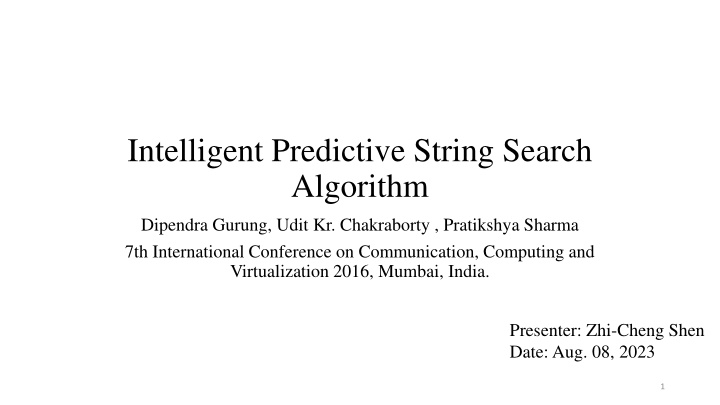
Intelligent Predictive String Search Algorithm Analysis
Explore the innovative intelligent predictive string search algorithm introduced at the 7th International Conference on Communication, Computing, and Virtualization. This algorithm presents a unique approach to string searching without the need for pre-processing, offering simplicity and efficiency in various applications such as data mining, sentiment analysis, and DNA pattern matching.
Download Presentation

Please find below an Image/Link to download the presentation.
The content on the website is provided AS IS for your information and personal use only. It may not be sold, licensed, or shared on other websites without obtaining consent from the author. If you encounter any issues during the download, it is possible that the publisher has removed the file from their server.
You are allowed to download the files provided on this website for personal or commercial use, subject to the condition that they are used lawfully. All files are the property of their respective owners.
The content on the website is provided AS IS for your information and personal use only. It may not be sold, licensed, or shared on other websites without obtaining consent from the author.
E N D
Presentation Transcript
Intelligent Predictive String Search Algorithm Dipendra Gurung, Udit Kr. Chakraborty , Pratikshya Sharma 7th International Conference on Communication, Computing and Virtualization 2016, Mumbai, India. Presenter: Zhi-Cheng Shen Date: Aug. 08, 2023 1
Abstract 1 Text processing has moved beyond merely word processing and desktop publishing softwares, which currently form a miniscule part of its application. With the advent of the internet and the huge amount of text processing associated with information mining, string search algorithms have gained importance. In this paper a new string searching algorithm is presented that uses intelligent predictions based on text features to search for a string in a text. The proposed algorithm has been developed after analyzing the existing algorithms such as KMP, Boyer-Moore and Horspool. One unique feature of this algorithm is that unlike the existing algorithms, it does not require pre-processing the pattern to be searched. 2
Abstract 2 As a result it does not incur the overhead required in pre-processing the pattern. The algorithm searches through a given text to find the first occurrence of a pattern. It does not involve complex computations and uses simple rules during a match or mismatch of a pattern character. Based on the variety of applications coming up in areas of data and information mining, sentiment analysis, DNA pattern matching etc, this simple, elegant and intelligent algorithm will find its application. 3
Boyer Moore Algorithm T = This is an alemple eleaple P = eleaple 4
Boyer Moore Algorithm T P T e h l i e s a i l s e a n a l e m p l e e l e a p l e p 5
Boyer Moore Algorithm T P T h i s i s a l n e a p l l e e m p l e e l e a p l e e a 6
Boyer Moore Algorithm T P T h i s i s a n a e l l e e m a p p l l e e e l e a p l e 7
Boyer Moore Algorithm T P T h i s i s a n a l e m p l e e e e l a e p a l p e l e l 8
Boyer Moore Algorithm T P T h i s i s a n a l e m p l e e e l l e e a a p p l l e e 9
Bad character 0 e 1 2 e 3 a 4 p 5 6 e l l bmbc[] e 4 a 3 p 2 * 7 l 1 11
suffix P = eleaple Suff[6] = strlen = 7 Suff[5] = 0 Suff[4] = 0 Suff[3] = 0 Suff[2] = 2 Suff[1] = 0 Suff[0] = 1 12
Good suffix Case 1 Case 2 Case 3 13
Bmgs[] P = eleaple Suff[6] = 7 bmgs[5] = 6 bmgs[3] = 6 Suff[5] = 0 bmgs[6] = 5 bmgs[2] = 6 Suff[4] = 0 bmgs[4] = 4 bmgs[1] = 6 Suff[3] = 0 bmgs[6] = 3 bmgs[0] = 6 Suff[2] = 2 bmgs[6] = 2 case 2 Suff[1] = 0 bmgs[6] = 1 Suff[0] = 1 case 1 14
Time complexity Preprocessing: O(m+ ) Run time complexity: best: O(n/m) worst:O(n*m) 15
The Proposed Algorithm T P c c a u t t y e i s c u t e 17
The Proposed Algorithm T P c a t y i c s u c e u t e t 18
The Proposed Algorithm T P c a t y i s c u u t t e e c 19
The Proposed Algorithm T P c a t y i s c c u u t t e e 20
Thanks~ 21
